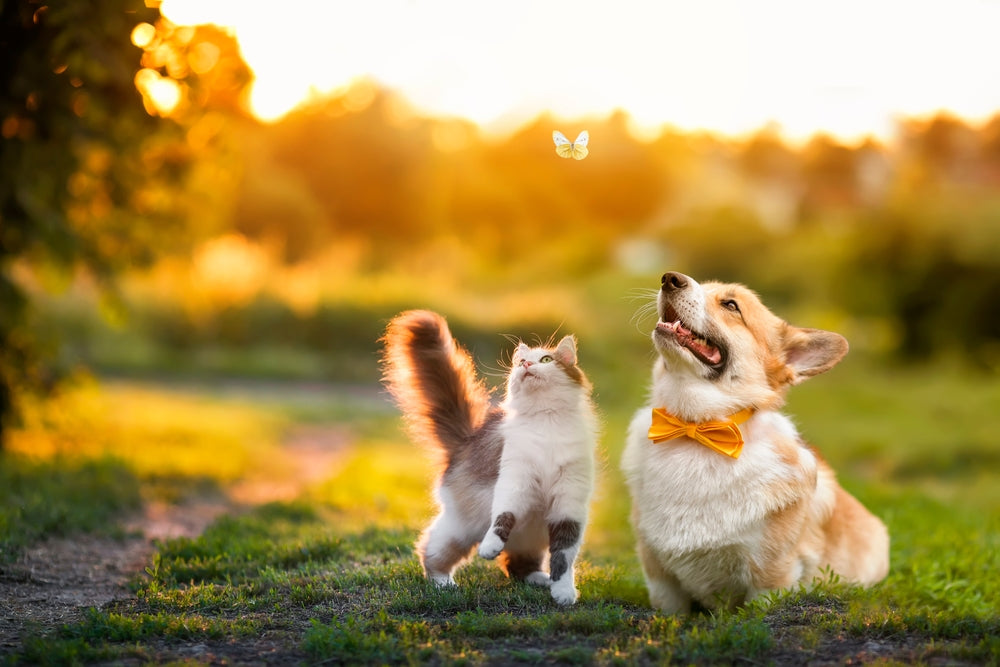
It’s inevitable - if you love four-legged creatures as much as we do, there will come a time when you’ll be faced with the challenge of introducing your current pet to your new pet.
Adding pets of the same species is one thing, but it’s a bit more of a conundrum to introduce cats and dogs.
If you’re planning on introducing your cat to a new dog - or vice versa - follow these steps to make the process as smooth as possible.
Setting Your Pet Up for Success
Before you bring your new (furry) bundle of joy home, make sure you prepare. Start by making sure there’s plenty of space for your cat to get some distance and alone time. Cats are easily stressed out, which can cause all sorts of health problems. So make sure your cat has plenty of opportunities to “get away from it all.”
Since dogs tend to like to sniff, lick, and sometimes “mark” anything within reach, your best bet is to give your cat the advantage of height. Options include adding a cat perch to your home,creating high shelves, or clearing off high tables and window sills for your cat. Another option is to designate one room as a dog-free room that your cat can run to when she needs a break.
It’s best to introduce your dog and cat when your dog is still a puppy. In puppyhood, dogs are more likely to learn that it’s not OK to chase, bite, or pounce on the family cat.
Of course, if you’re adopting a dog who’s already an adult, that’s not exactly an option. In that case, it may take longer for your dog to get the memo that your cat is his roommate, not his plaything, but it’s still possible. Here’s how.
The First Meeting

Give ‘Em Room
When your dog and cat meet for the first time, make sure it’s in a room with plenty of space. Put your dog on a leash, tell him to sit (if you’re still working on this skill, this is a perfect opportunity to reinforce it), and give him a treat. Continue to reward your dog for sitting still, being calm, or ignoring your cat. Any positive, pet-parent-approved behaviors deserve a treat.
Let your cat wander around freely. Be sure not to hold your cat, trap her, or force her to interact with your dog. Your cat will gradually come around to the idea of living with a dog, but the first interaction may be brief while your cat figures out what’s going on.
Some cat breeds are more likely to make friends with canines, while others prefer the company of humans and other cats. Either way, it’s important not to force your cat into the relationship and let her escape when she’s ready to call it quits. Don’t worry - her natural curiosity will have her back in no time.
Body Language
Keep an eye on your pets’ body language. If your dog stiffens, stares at your cat, barks, whines, pulls towards, or attempts to chase your cat, it may indicate that your dog has a strong prey drive (in other words, he likes to chase and catch things he sees as prey). However, if your dog seems more curious and playful, it’s a good sign that your cat and dog will be able to live together in harmony - in time.
You’re The Boss
If your dog tries to lunge at your cat, growls, or snaps, tug firmly on your dog’s leash and say, “No!” in your best booming, parental voice. Your new dog needs to learn that you’re the boss in this household and if you say the fluffy thing with the big eyes and long tail isn’t a toy, then your dog had better listen.
Alternative Methods
When you’re not around to babysit the new odd couple, keep your dog in a kennel. Dog kennels or crates are great for teaching potty training and obedience skills,when used properly.
If supervised interactions and allowing your cat and dog to get used to one another with a dog kennel between them still doesn’t work, consider the Look At That method. This training technique teaches your dog that it’s more rewarding (treats!) to pay attention to you for a command than to fixate on your cat.
Budding Friendship

Over time, your cat will warm up to your dog as long as she doesn’t feel threatened by him. While your new dog is getting used to the way your household operates, keep him on a leash (yes, even indoors) and tethered to you whenever he’s in the same room as your cat. This will allow you to put an end to any bad behavior on your dog’s part the second it happens.
The more your dog learns that the cat isn’t a chew toy, the more comfortable your cat will feel around your dog. If your dog does threaten your cat (even if he doesn’t mean to), your dog may end up with a paw - and claws - to the snout.
If this happens, don’t punish your cat. After all, she’s just defending herself. Simply separate them and give it another go once they’ve both had time to calm down.
In time, your cat may even come to love your dog. Your dog will learn boundaries based on how you and your cat respond to his behavior. Remember to always focus on rewarding positive behavior and minimizing punishment.
Do you have experience living with both cats and dogs? Share with us your favorite family picture showing off your family’s species diversity
----


Follow Us